Soil huggers
Low lying plants that cover the ground are worth their weight in gold. Less energy demanding lawns and kinder to the environment than hard surfaces, weed-blocking groundcover plants are also very beautiful to look at.
Many stay green with minimal watering, offering a cooling effect on hot days and removing dust particles from the air. Used as living mulch below taller plants, to soften path edges, or to breath life into dull corners, nature’s creeping carpets bring seasonal interest with their flowers and changing foliage tones. Many are fragrant too.
At the same time, they insulate the soil from temperature extremes, prevent erosion, provide a habitat for wildlife and generally take care of the most precious natural resource in our own back yards. And of course, only living breathing ground surfaces can remove carbon from the atmosphere.
Some groundcovers tolerate a fair amount of foot traffic, which makes them useful lawn substitutes for smaller areas. Most are very effective weed barriers. However, it’s important to eradicate persistent perennial weeds (such as oxalis and invasive grasses) before planting. These can grow from small remains and will push their way through.
20 of the best groundcovers
| 1 | Drought tolerant Mondo grass (Ophiopogon) is perfect for mass planting in sun or part shade, around paving, in pots or as an expansive groundcover. The dark green grassy foliage looks great all year round. There are a number of species including a very low growing dwarf form and stunning black Ophiopogon ‘Nigrescens ’ . |
| 2 | Thyme releases its scent when crushed and is an excellent groundcover for planting around stepping stones. It also makes an attractive lawn substitute, with pretty flowers in summer which bees love; not good for bare feet! |
| 3 | Chamomile makes a lush green carpet that releases a delicious perfume when walked on. The best for lawns is the sterile (non-flowering) form, ‘Treneague’ which is produced by division or cuttings, not seed. So an instant lawn will be expensive. |
| 4 | Tiarellas are tough woodland plants with sculptural leaves with distinctive dark veining. In spring and summer they produce clouds of soft, 'mist-like' flowers. Tiarellas love to grow in humus rich soil under the shade of trees, growing sideways via lateral growths to form an easy care but non-invasive groundcover. |
| 5 | Turf lily (Liriope muscari) makes a great path border or mass planting under trees, where it will cope with dry soil as well as shade. Clumps are divided and transplanted in winter or spring. Blue or white flower spikes rise from the strappy dark green leaves in autumn. |
| 6 | Ajuga forms thick mat of lush foliage all year round. In spring, there are upright clusters of blue flowers. There is a range of very attractive leaf forms to choose from, including ‘Black Scallop’ pictured here. Ajuga will grow in sun or shade and prefers moist soil. |
| 7 | Handsome hardy Heucheras loved for their colourful ever present foliage make excellent groundcover for semi-shade. Available in an astonishing range of colours. Pretty spring flowers are a bonus. |
| 8 | A colourful groundcover option for full sun, gazanias (aka African daisies) are ideal coastal or container plants. Also useful cover for hot dry bank, they offer brilliant shades of yellow, orange, red and pink, flowering for many months over spring summer and autumn. Frost tender. |
| 9 | Ideal for sandy coastal gardens, Fuchsia procumbens is a pretty native creeper. The tiny yellow flowers have prominent red stamens and blue pollen. Red berries follow flowering. It grows in sun or light shade but needs protection from frost. |
| 10 | Pōhuehue (Meuhlenbeckia axillaris) is great for carpeting large areas around trees and shrubs. It has fine dark green foliage and spreads to about two metres. Best in sun. |
| 11 | New Zealand’s small leafed Coprosma groundcovers are extremely tough and reliable sprawling shrubs, tolerant of hot dry and coastal locations. These great weed suppressors are ideal for covering dry slopes and quick to establish after planting. Sand dune coprosma (Coprosma acerosa) makes a springy weed–supressing blanket. Coprosma Hawera lies very flat to the ground. The Coprosma kirkii cultivars have a low mounding habit with shiny leaves. |
| 12 | Moss plant (Scleranthus), loved for its bright green colour and smooth texture, thrives in sunny well drained location. It needs full sun and well drained soil. Brown patches are easily cut out and ‘patched with rooted divisions from the side of the plant. |
| 13 | Leptinella is a quick growing New Zealand native with small fern-like leaves. Though lovely as a lawn substitute in light traffic areas, it is not one for drought prone gardens, needing moist free draining soil. A range of varieties includes bright green Leptinella dioica or for a touch of dark contrast, Leptinella ‘Platts Black’. |
| 14 | Panakenake (Lobelia angulata) is a New Zealand native with white lobelia–like flowers on a dense mat of tiny green leaves. Grow this popular groundcover in moist soil with sun or light shade. It is best in frost–free climate. |
| 15 | New Zealand native Acaena inermis ‘Purpurea’ makes a colourful contrast all year round with its rich purple red foliage. |
| 16 | Japanese spurge (Pachysandra terminalis) is a shade loving and drought tolerant groundcover with dark green shiny leaves that makes a dense weed-suppressing carpet. Related to English box, it is slow growing but very tough once established. Best in cooler climates. |
| 17 | Creeping Juniper (Juniperus procumbens) is a ground hugging conifer. Slow growing but very tough, long lasting and easy to care for. |
| 18 | Mercury Bay creeper (Dichondra repens) is a bright green lawn alternative that copes well with moderate foot traffic and when gown in full sun, doesn’t need mowing. Tiny, kidney shaped leaves form a lush spreading carpet. It can be grown from seed or by transplanting ‘plugs’. Weed removal before planting is essential and some hand weeding is usually needed to prevent grassy weeds taking over. |
| 19 | Attention seeking Spanish Shawl (Heterocentron elegans) stands out from the crowd with its smothering of intense cyclamen–pink flowers on a very dense ground clinging plant. Leaves turn reddish in winter. Frost tender. |
| 20 | Tiny leafed blue star creeper (Isotoma fluviatilis) forms a tight carpet lavishly sprinkled with blue starry flowers from spring till autumn. Lovely with stepping stones, it’s easy to grow in moist soil in sun or light dappled shade. |
Groundwork
- Soil improvements made prior to planting are an investment in faster plant establishment. Add compost to improve heavy clay or light sandy soils.
- Adding slow release fertiliser will help plants establish faster, but take care to meet individual plants needs. Some ground covers prefer soils with low fertility.
- If drainage is poor, raise the soil level. This also gives rise to a warmer soil and faster growth in early spring.
- Before planting, spray to eradicate persistent perennial weeds. If bringing in compost or top soil, check its is free of invasive weeds.
TIP: Space plants more closely than you otherwise would to achieve dense cover more quickly.

28-Feb-2021
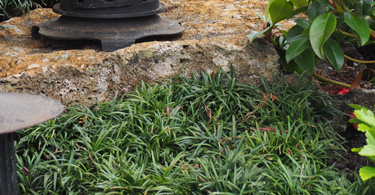
Ophiopogon
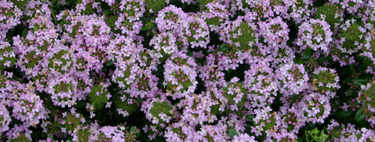
Thyme

Tiarella
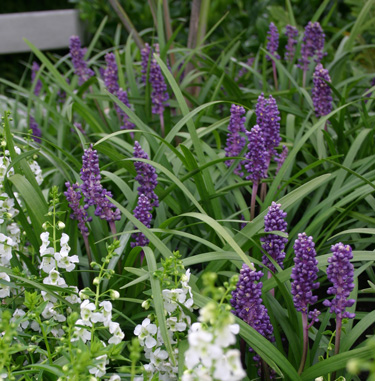
Turf lily

Ajuga
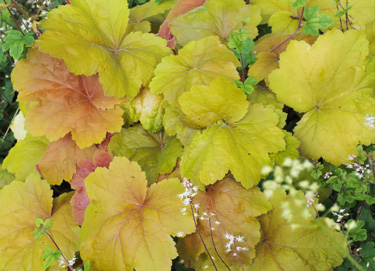
Heuchera
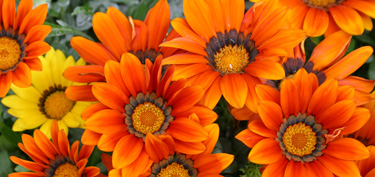
Gazania
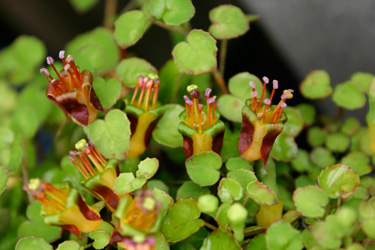
Fuchsia procumbens
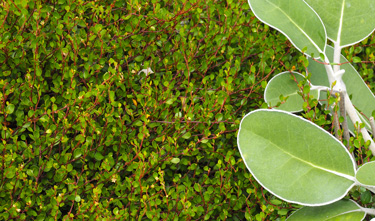
Pohuehue
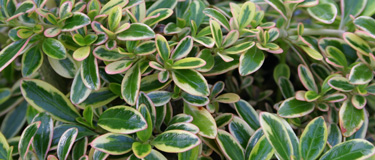
Coprosma Kiwi Silver
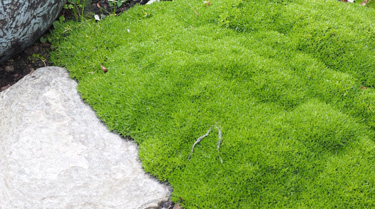
Moss plant
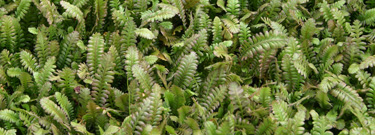
Leptinella
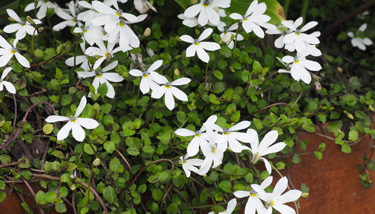
Panakenake

Aceana 'Purpurea'

Japanese spurge
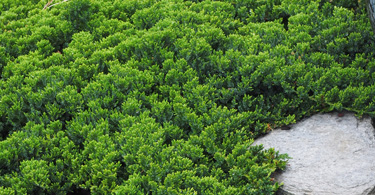
Juniper procumbens
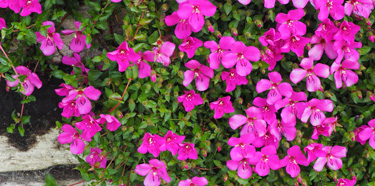
Spanish shawl

Blue star creeper

